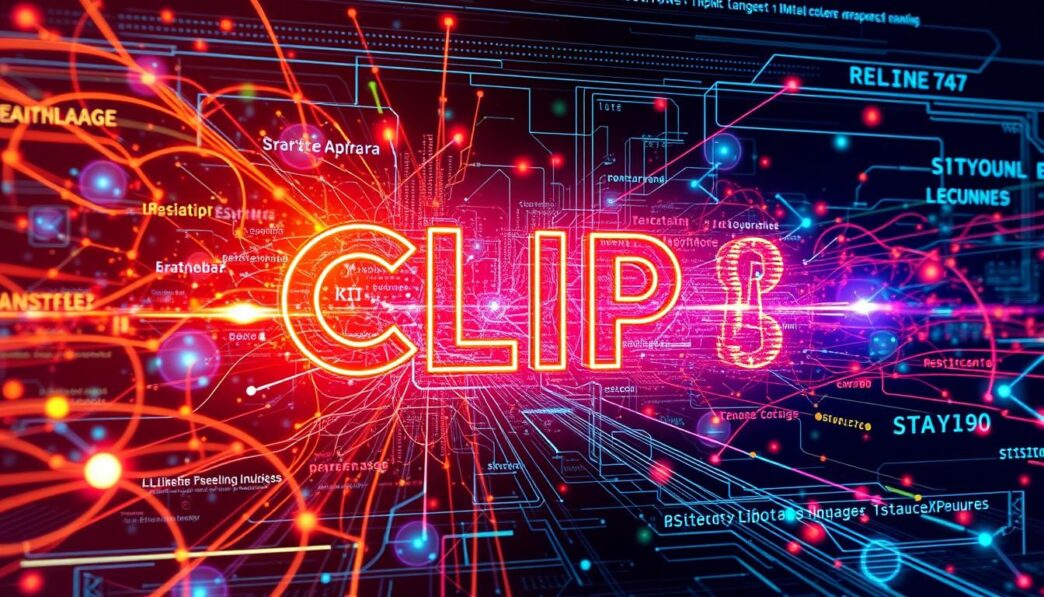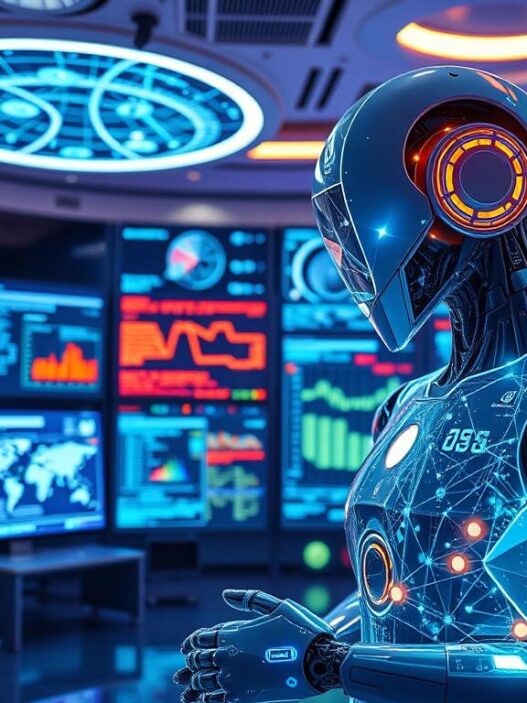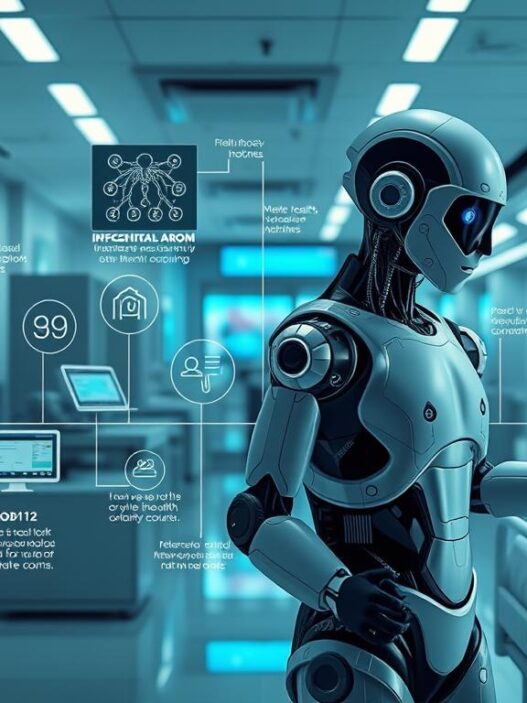In the world of AI vision technology, CLIP is a big deal. It’s like a bridge between what we see and the words we use. With a huge pool of 400 million image-text pairs, its skills in image recognition and visual search are top-notch12. This model is smart. It learns without being directly taught and gets better at understanding pictures with words13.
CLIP is leading the way in how computers understand our world. It makes it easier for machines to understand us and our environment better.
Key Takeaways
- OpenAI’s CLIP leads in bridging the text-to-image connection using rich datasets and natural language.
- CLIP’s versatility extends beyond traditional metrics, promising advances in zero-shot learning and image recognition.
- The innovative architecture of CLIP optimizes efficiency, achieving notable accuracy in visual search applications.
- Addressing multimodal AI challenges, CLIP navigates object recognition and class distinctions with ease.
- CLIP’s embrace of contrastive learning elevates its capacity to process and understand vast, diverse image-text pairs.
- Despite its prowess, CLIP requires significant data and computational power, reflecting the evolving landscape of AI vision technology.
Understanding CLIP’s Breakthrough in AI Vision
The breakthrough AI vision tool, CLIP, has changed our view of how AI links visuals and text. OpenAI developed it, using a process called contrastive learning4. This has led to improvements in AI systems that can handle both text and images.
The Concept of Contrastive Learning
Contrastive learning is key to how CLIP works so well. It teaches AI to spot what’s the same and what’s different between image and text pairs. This method helps the AI create strong links between text and images, letting it handle various tasks without needing specific training first4.
Decoding CLIP’s Dual-Encoder Architecture
CLIP’s design includes a dual-encoder system for processing text and images separately. The text is handled by a transformer architecture, and images get processed by a CNN4. CLIP can then pair related texts and images with impressive accuracy. This shows its ability to adapt to different tasks, even when it hasn’t been trained on them before5.
From Image-Text Pairs to Shared Latent Spaces
Using 400 million image-text pairs during training was key for CLIP. This large dataset helps it understand and sort new images by comparing them to what it has already learned653. Through these comparisons, CLIP places text and images into a unified mathematical space. This lets it accurately judge how similar they are5. It aims to align each image or text with its correct match while avoiding wrong pairings. This enhances its ability to predict outcomes for AI vision and language tasks5.
Learning about CLIP’s special dual-encoder layout teaches us more about AI’s current capabilities. Using contrastive learning in this setup shows us new ways to push AI forward. It helps AI become more flexible and skilled than ever.
CLIP: Connecting Text and Images – Nurture of Multimodal Models
The creation of multimodal models like CLIP by OpenAI marks a big leap in AI learning. These models blend visual concepts with words to get better at recognizing images. They use huge text-image datasets to learn and name pictures in a wide, in-depth way, beating old methods7.

Multimodal models are great because they handle different kinds of data. This makes them very good for AI learning that mixes pictures and text. They help image classification systems get better by learning from varied, big datasets with lots of real-world visual concepts and situations7.
| Feature | Impact on AI Learning | % Increase in Performance |
|---|---|---|
| Multimodal Data Integration | Enhanced understanding of complex inputs | 37% |
| Large text-image Dataset | Broader learning scope | 55.8% |
| Visual Concepts Interpretation | Improved accuracy in image classification | N/A |
Using large datasets makes AI learning richer, allowing machines to do tasks like zero-shot learning well. This skill is key for models that handle new data with little change needed78.
Learning with lots of text-image datasets gives models a chance to see varied visuals and text. This boosts their skill in understanding both words and pictures together8. Training this way makes these systems work better in many uses, making a new standard for AI’s interaction with the world.
Technologies like CLIP show a big change in how AI learns. These multimodal models have changed how AI systems see and interact with complex data, changing image classification and understanding of visual information.
The Strategic Training Process of CLIP Models
The CLIP training process links words with images in a new way. This changes how AI understands different kinds of information. By knowing top methods, we see the big role of huge datasets and special loss functions. They help make AI systems better at adjusting.
Pre-training on a Large-scale Image-Text Dataset
At the heart of the CLIP model’s success is its early training stage. Here, it uses 400 million pairs of images and texts9. This giant collection boosts the model’s skills and makes it better at guessing outcomes in different situations. With a big training group size of 32,000, it gets really good at noticing complex patterns9.
Creating Classifiers from Label Text
CLIP’s smart design turns simple labels into classifiers. This happens by matching visuals with their descriptions well. Experts like Yann LeCun say this kind of learning—doing things on its own—is game-changing9.
Zero-Shot Learning Enhanced by Contrastive Loss Functions
Zero-shot learning gets a big boost in CLIP through contrastive loss functions. These functions carefully check and adjust how similar the image and text matches are. This accuracy lets CLIP work well even in situations it wasn’t specifically trained for. It shows how flexible and useful the model can be9.
What makes CLIP special is its focus on learning from both text and images at once9. It uses advanced systems for texts and images, making it simple but powerful9.
For more details on CLIP, check this tutorial on how to implement the CLIP.
| Feature | Impact | Technique |
|---|---|---|
| Large-scale training datasets | Enhances generalization capacity | Pre-training with image-text pairs |
| Contrastive loss function | Refines accuracy in pairing | Measuring similarity using cosine metrics |
| Zero-shot learning capabilities | Extends model utility without additional training | Applying learned embeddings to new tasks |
By using contrastive learning and big datasets, the CLIP training process leads in AI. It also opens doors for better combining language and vision in the future.
How CLIP Overcomes Challenges in Computer Vision
OpenAI’s CLIP model is changing computer vision in big ways. It tackles the semantic gap, improves how AI systems learn, and works well in different situations. Thanks to its large dataset and learning skills, it’s great for real-world use.

One big issue in computer vision is the semantic gap. It’s the difference between what computers see and what they need to understand. CLIP fixes this by matching pictures with text descriptions. This helps computers understand context better than before.
CLIP is also more efficient with data than older methods. It doesn’t need as much labeled data to work well. Training on 400 million image-text pairs, it can recognize new images accurately even without extra training1011.
Moreover, CLIP makes AI in computer vision more explainable and flexible. It uses language to label images, so it’s easier for us to understand its choices. This builds trust and lets AI be used in more ways. Its strong performance, despite changes in data10, shows it’s reliable and adaptable.
| Feature | Benefit |
|---|---|
| Semantic Bridging | Reduces the semantic gap by integrating contextual descriptions. |
| High Data Efficiency | Achieves better results with fewer data through extensive pre-training1011. |
| Explainability | Offers understandable, natural language explanations of visual content. |
| Generalizability | Maintains accuracy across diverse scenarios without additional training10. |
The combination of these advanced features marks CLIP as a leader in AI for computer vision. It’s shaping the future of AI applications, improving both how we develop and use AI technologies.
Practical Implementations: CLIP’s Versatility in Application
OpenAI’s CLIP has changed AI in big ways, like with zero-shot classification and NLP. It learned from 400 million internet-sourced image-text pairs12. This highlights its use in making text-to-image art and more. Also, MetaCLIP’s beats CLIP’s models with a 70.8% success rate13.
Expanding the Horizons of Zero-Shot Image Classification
CLIP is great at understanding pictures it wasn’t specifically taught about. It does this by comparing images with text descriptions12. This tech can recognize over 40,000 famous faces with few examples12. MetaCLIP improves this, getting up to 80.5% accuracy13.
Integrating NLP for Advanced Image Processing Capabilities
CLIP combines NLP to do more than just classify images. It can now accurately describe pictures. This shows how AI can understand and answer questions about pictures12. MetaCLIP goes a step further by being even better at these tasks13.
The Emerging Field of Text-to-Image Generation
Text-to-image creation is growing fast, thanks to CLIP and others. They can make and change pictures from text ideas12. MetaCLIP is pushing this even more, improving image tasks. This points to a big future for AI in creativity13. Check out more amazing AI tools at viso.ai.




















